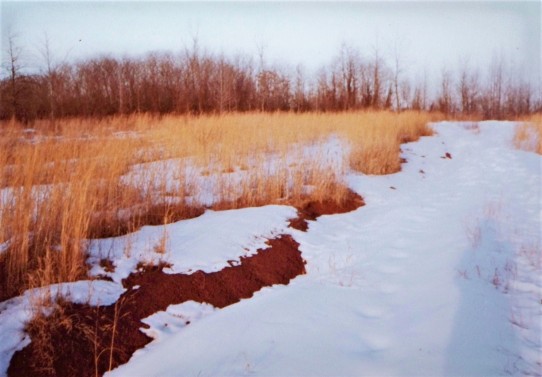The idea for this blog has been fermenting for a long time, and I didn’t even know it. It’s about a place that once was bigger but not much. The fragments of this place were strung along the floodplain of the South Fork of Beargrass Creek and the steep slopes that rose up out of it. In the middle of urban Louisville, they’d been abandoned when people ceased to farm them.
As teens in the 70’s, my friends and I discovered one of these bits of city wildness, and went there regularly on our bikes to do the sorts of things teens couldn’t do anywhere else. This one of the few pics I have of the place we called St. Agnes. It was a wasted, red clay old field ridgetop, deeply eroded, sloping down to an almost impenetrable thicket of blackberry and Japanese honeysuckle on the floodplain. I didn’t know what an invasive plant was then, but was astounded at how you could get so lost and trapped in a mass of vines.
As over time my friends drifted off, I came back again and again. I got binoculars and a bird book, and stalked a yellow breasted chat – that hooting, chuckling song of long hot summer days, hidden in a thicket. Saw a grey fox (its tracks are in the photo). Found a whippoorwill sleeping in broad daylight, flattened on a low branch like a piece of bark. The list goes on and on – I was hooked.
That place is gone now, the land covered by useful things – a hospital, a mini mall, a cemetery, a subdivision. One piece is left, one good chunk. Beargrass Creek State Nature Preserve, the subject of this blog. The land for the preserve was purchased in the early eighties, about the time all the other bits were going under the bulldozer. So it will be here, next year-next century quite likely. But what exactly will it be?

There are other ways to trash a forest, less dramatic than a bulldozer. In the case of an urban nature preserve, just do nothing. Year by year birds will deposit the seeds of all the berry producing plants for miles around. Seedlings of the non-native, fast-growing ones that produce the most berries will begin to increase. Like a forest- wide game of musical chairs, the native plants won’t be fast enough to grab a seat. Eventually they lose the game. The outcome? A forest in name only, robbed of most plant diversity.

So here we are, hardy volunteers taking the seats back again. Ousting the invaders, planting native seed, transplanting native shrubs, trying to thwart the hungry mouths of deer. Will it work?
Read on …
hope springs eternal!

